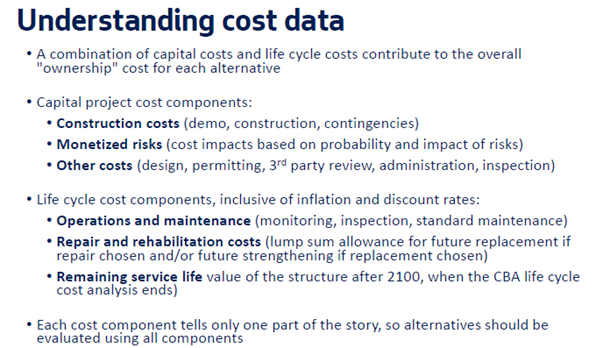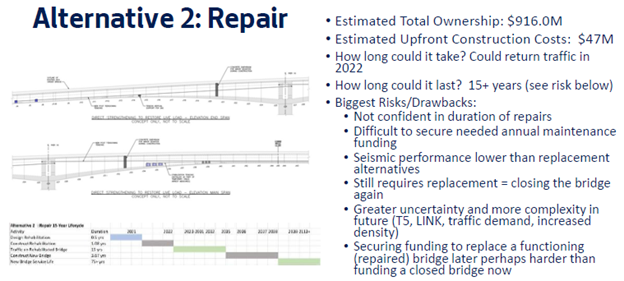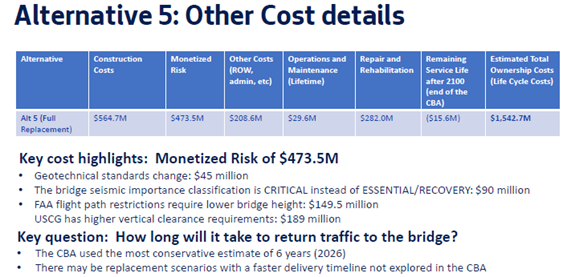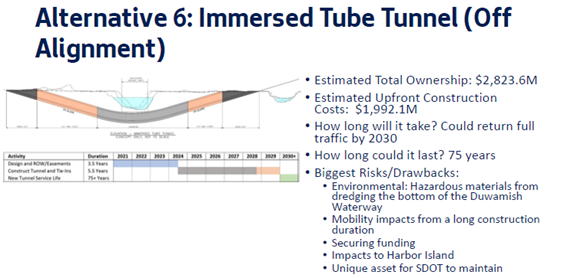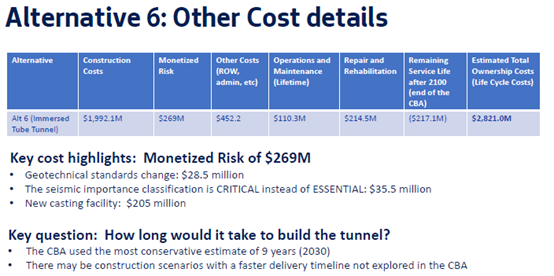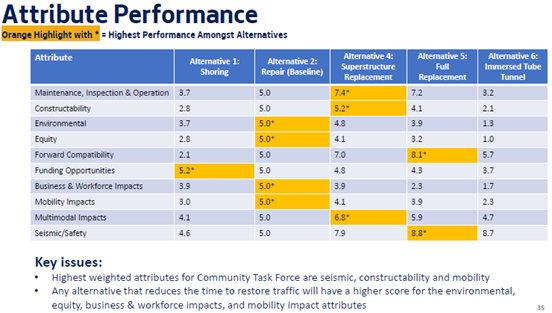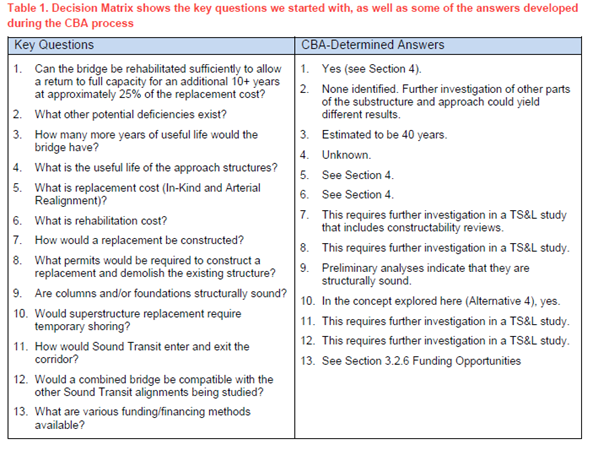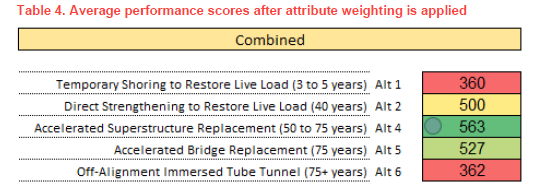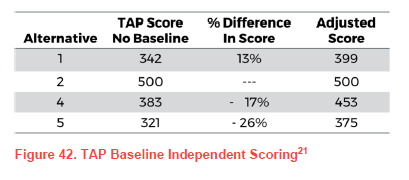West Seattle Bridge Update, October 23
This week SDOT released the Cost Benefit Analysis (CBA) report, developed to inform the decision whether to repair or replace the West Seattle Bridge. SDOT has a blog post about this, which includes a link to a reader’s guide. The CBA includes cost estimates for construction and operations and maintenance, and includes monetized risk and life-cycle costs. Monetized risk is a phrase used throughout and it means a calculation of potential cost impacts, based on probability plus impact of risks.
SDOT briefed the West Seattle Bridge Community Task Force on Wednesday; the task force will consider recommendations on the CBA next Wednesday, October 28th.
The task force also heard other updates from SDOT, and also a presentation from HTNB, the design company hired by SDOT, about an option they call “rapid span replacement.
Updates
SDOT has been continuing work on stabilizing the West Seattle Bridge; this is an important element of any potential repair option.
Here are Reconnect West Seattle projects that have been completed:
SDOT’s target date for activating the automated enforcement system on the lower bridge is December 1st, with warning notices issued in December, and a target date for violation notices to begin on January 1st, 2021. Cameras will be mounted at the bridge entrance, with warning signs; signs will be installed soon to note upcoming enforcement. SDOT has created a Low Bridge Access Subcommittee to examine use of the bridge; once enforcement begins, new traffic patterns may emerge that could allow for more flexible use of the lower level bridge.
Cost Benefit Analysis
In the CBA, SDOT emphasizes the cost figures are rough order of magnitude projections, not cost estimates. These conceptual options are at 0% design.
The capital project costs listed include construction, monetized risks, design and 3rd party review. The life cycle costs include O&M, repair/rehabilitation, and remaining service life through 2100:
Of the alternatives examined, alternative 1 is expensive, with a short lifespan:
Alternative 2, Repair, shows an upfront construction cost of $47 million, and could return traffic in 2022; SDOT notes potential drawbacks below:
Additional detail shows much of the ownership cost comes via the need to replace it before 2100, and O&M lifetime costs of $40.5 million, while noting further study needed for increased certainty on duration of repairs:
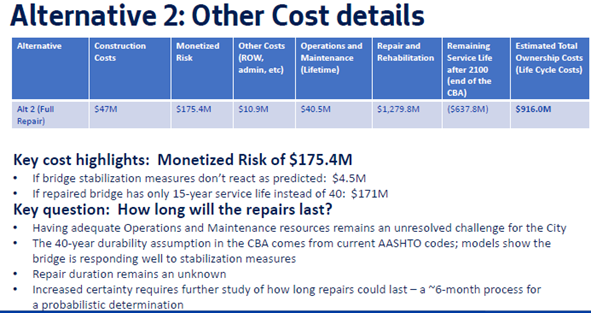
Alternative 4 is a superstructure bridge replacement, with upfront constriction costs at $383 million, and a 75 year life. It estimates traffic reopening in 2026.
Here’s additional detail; an example of monetized risk is $189 million for the potential for the US Coast Guard to want higher vertical clearance beyond the current 140 feet. Lifetime O&M costs are $22 million:
Alternative 5 is a full replacement, with a $564.7 million construction cost estimate; there could be greater risks with Coast Guard permitting. It would last 75 years, and open in 2026.
Lifetime O&M is estimated at $29.5 million. The monetized risk included is $149.5 million for the FAA, regarding flight path restrictions for a higher bridge.
Alternative 6 is an immersed tub tunnel, estimated at $1.99 billion for construction, with a 2030 opening date:
Lifetime O&M is estimated to cost $110 million:
Here’s how the alternatives compare based on the attributes included in the CBA; a repair is the baseline, so it’s rated 5.0; other options are rated in comparison. The repair option rates best on the following attributes: equity, environmental, business and workforce impacts, and mobility impacts, with a shorter closure. Other options rate higher on these attributes: O&M, constructability, forward compatibility, funding opportunities, multimodal impacts, and seismic/safety.
Here’s a comparison of annual average (and total through 2100) operations and maintenance costs:
The Cost Benefit Analysis (CBA) report is 89 pages and dense. It includes more detailed information about what’s described above. Below are a few examples of what is included.
Here’s the decision matrix of the key questions considered:
Here’s a chart showing the diversion routes due to the bridge closure. It shows the greatest impact in neighborhoods with higher percentages of people of color. It estimated options 2, 4 and 5 had the least impact on communities of color, due to shorter closures, compared to options 1 and 6.
Charts are shown for the attributes from the CBA. Here’s the one for business and workforce impacts:
A summary of attribute findings, using ratings from SDOT, the Community Task Force, and the Technical Advisory Panel found Alternative 4 (Superstructure Replacement) with the highest score:
On the other hand, the Technical Advisory Panel analysis found Alternative 2 (Repair) had the highest score:
In the monetized risk section, it notes the risk of a repair not meeting a 40 year service life is very low (less than 5%). The CBA includes several sensitivity studies. Sensitivity studies assess the potential for different CBA outcomes under a set of different assumptions, and show how even slight variations in assumptions can yield different CBA outputs. Separate studies were done on service life, existing bridge seismic/safety performance, cost contingency impacts, risk monetization impacts, accelerated construction impacts and discount rate.
The studies overall found that the Repair option has the highest value index. The value index is the ratio of performance to cost, The repair option also has the highest potential for an increase in value index.
Rapid Span Replacement
The CBA includes high-level replacement options. SDOT has said they are interested in pursuing options for a replacement that could be completed sooner than 2026. I appreciate SDOT considering any options or construction or design methods that can tighten timelines; 6 years is far too long.
SDOT’s design consultant, HNTB, presented to the task force on Wednesday about a proposal based on their work on a bridge at Lake Champlain, which was completed in two years. This option was not included in the CBA; it fits within Alternative 4, Superstructure replacement.
The forthcoming decision is about repair and replacement only. If replacement is chosen as the preferred alternative, a 12 week “Type, Size and Location” study would be needed to consider the various replacement options. That would get design to 30%.
For this option, HNTB suggests it could be completed in early 2023. The main center span would be developed offsite, brought in by a barge, and raised. For this reason, demolition and construction work could proceed at the same time.
Their assumptions are below:
Schedule risks include permitting. One assumption is that, because there is minimal in water work, permits could be obtained faster than usual. This would depend on a high degree of interagency cooperation at multiple levels. Funding would also need to be obtained relatively quickly. The site, for purposes of construction, is relatively constrained as well.
HNTB says the bridge would have a lower weight, with the use of steel, reducing the stress on the existing pilings, and enhancing seismic performance. They indicate that, in the future, elements of the bridge could be replaced while the bridge remains in service.
They indicated the potential for significantly shorter closures to maritime traffic during construction; the image below projects how a center span would be brought in by a barge and the challenges with the lower bridge.
Finally, HNTB projects a shorter construction schedule, with an opening in 2023, significantly shorter than the replacement options considered in the CBA, I.e. 2026.
This Week in the Budget
On Tuesday and Wednesday the Budget Committee continued Issue Identification sessions, where Central Staff reports on the Mayor’s proposed budget, and identifies potential issues for the Council to address. Councilmembers can also raise issues, or potential proposals.
Here are the presentations from this week:
October 20
Parks and Recreation I Central Staff Memo I Presentation
Department of Transportation I Presentation I Central Staff Memo
Police Department I Central Staff Memo I Presentation
October 21
Community Safety and Violence Prevention | Memo | Presentation
Human Services Department | Presentation | Memo
Homelessness Response | Presentation | Memo
Citywide COVID-19 Response | Presentation | Memo
Next week the Budget Committee will meet on Wednesday through Friday to hear Council Budget Actions and Statements of Legislative Intent. This round will include more detailed proposals than during Issue Identification; these proposals also require two co-sponsors. The Budget Chair will consider these proposals in developing a Balancing Package, scheduled for November 10th.
You can view or download the full Select Budget Committee meeting calendar here. Sign up to receive Select Budget Committee agendas by email here.
Public comment will be taken at the start of each meeting at 9:30 a.m. You can register to give comment on this page. The signup form is available two hours before each session begins.
Budget Public Hearing
On Tuesday the 27 at 5:30pm the Council will host its second Public Hearing on the Budget. Check out the committee website here for committee dates and to sign up for public comment for the Public Hearing. You can register for public comment two hours before the meeting begins and the hearing will go until everyone has been heard.
Below are some of the items I proposed during this week’s Issue Identification meetings.
Homeless Outreach for D1:
I am requesting the addition of a homeless outreach worker dedicated to West Seattle and South Park. This position would support individuals facing behavioral health (including substance abuse and/or mental health issues) and homelessness in our neighborhoods to access services and reduce barriers to stable housing.
Social Service Provider Academy Support:
Provide funding to support students at the Social Service Provider Academy (SSPA) at Seattle Central College (SCC). This is a career development program that offers higher education opportunities to housing and homeless social services entry level staff, many of whom have been previously homeless themselves, who are working to advance in their field.
Duress and Di Minimis Defense Legislation:
This bill redefines the City’s definition of duress and di minimis in the Seattle Municipal Code to reduce the use of the King County Jail in instances where a jail sentence is not appropriate. If the bill passes, the duress and di minimis defenses could be utilized for individuals who, “at the time of the offense, experience symptoms of a behavioral health disorder or a behavioral health condition.” Or when, “the defendant committed the offense with the intent of meeting a basic need the defendant was experiencing at the time of the offense.”
Transferring Some Harbor Patrol Functions to the Seattle Fire Department:
Consistent with Resolution 31962, this proposal would work towards transfer of certain aspects and functions of Harbor Patrol from the SPD to SFD.
Sidewalk Repairs:
Increase funding for repairing sidewalks, as recommendation in the Policy Recommendations for Sidewalk Repair in Seattle, developed by SDOT with the Evans School at the UW.
Fauntleroy Boulevard Project:
The Mayor’s proposed budget eliminates funding for the Fauntleroy Boulevard Project. I do not suport this decision. Full funding for the project was included in the Move Seattle Levy, passed by voters in 2016. 100% design was reached in fall of 2017.
Implementation of that project was delayed in January 2018, however, because the project overlaps with one of the options under consideration for Sound Transit’s light rail project; consequently, a decision on implementation was delayed until completion of Sound Transit’s EIS process, expected to be completed in 2022.
SDOT’s Fauntleroy Project Website (dated November 1, 2019) committed to the objectives of this project:
“We remain committed to the goals of the Fauntleroy Boulevard Project. If Sound Transit’s light rail design for West Seattle does not impact Fauntleroy Way, we will move forward with the full project as designed. If Sound Transit’s design impacts Fauntleroy Way, we will work with Sound Transit to implement streetscape improvements on Fauntleroy Way that align with goals of the Fauntleroy Boulevard Project.”
The Role of Parking Enforcement Officers:
Expand the function of the proposed Seattle Emergency Communications Center to include Parking Enforcement Officers (PEOs) and rename the office the Seattle Community Safety and Communications Center (CSCC). Consider expanding the current role of the PEOs to assume functions currently provided by SPD sworn officers, which could include red light camera enforcement, school zone enforcement, response to non-injury collisions, response to and reporting on minor thefts and car break-ins, and traffic control. This would have the benefit of allowing armed officers to focus on work only they can do; 56% of calls SPD responded to in 2019 were non-criminal.
PEOs have passed extensive background checks, and are knowledgeable about police procedures. The Director of the PEO Guild has noted extensive language skills of PEOs in Amharic, Tigrigna, Soninke, Swahili, Luganda, Cantonese, Spanish, French, Bulgarian, Swedish and Malay; over 60% are BIPOC.
Implementing some of these items may require bargaining.
West Seattle Bridge/Reconnect West Seattle:
Require reporting for the West Seattle Bridge/Reconnect West Seattle program.
SPD Overtime Tracking:
This will be a request to SPD to report to the Council on use of overtime.
SPD Vacancies:
Remove vacant positions, some of which are funded, and invest those dollars into participatory budgeting.
SPD Budget:
This proposal would reintroduce reductions to the SPD budget adopted in the 2020 summer budget rebalancing. This includes proposals for out of order layoff reductions in sworn officers and reduction of overtime and travel. Those dollars would be invested into participatory budgeting.
CHEL Funding Transfer:
This proposal would move $1.4M that Council has provided for Community Health Engagement Locations (CHELs) from General Fund to the Human Services Department, with the expectation that HSD may contract those funds to Public Health for supervised consumption services.
Restore Funds Cut to Age Friendly Seattle:
Restore $60,358 to the Age Friendly Seattle operating budget for contracts and administration.
LEAD reporting:
In response to RES 31916 passed by Council in 2019, require reporting on projected referrals to LEAD from multiple referral pathways through 2023, and the resources required to bring LEAD to scale and ensure its ability to accept all referrals citywide.
Domestic Violence – Where to Find Help
If you or someone you know needs help, you can call, chat, or text, 24 hours everyday, at the National Domestic Violence Hotline at 800-799-7233. For more ideas and action steps that you can take to end domestic violence, visit: https://endgv.org/ or https://wscadv.org/dvam/.
In Washington State, 41 percent of women and 32 percent of men report experiencing violence from an intimate partner. The City of Seattle invests more than $10 million annually in community programing focused on gender-based violence. Through these investments, HSD and partners support more than 10,000 survivors each year.
While domestic violence does not discriminate, language barriers, lack of culturally relevant services, threats of deportation, and fear of isolation put marginalized communities at an increased risk of experiencing gender-based violence. Women of color and Native women are two-to-three times more likely to experience a gender-based, violence-related fatality than their white counterparts.
Yesterday was Purple Thursday, a day when we are asked to honor and stand in solidarity with survivors of domestic violence by wearing purple. October is Domestic Violence Awareness Month, which the Human Services Department (HSD) and the Office of Labor Standards (OLS) have recognized as a time to remember victims and survivors of abuse and exploitation; to raise awareness about violence and its effect on families and communities; and to acknowledge and highlight those working to end gender-based violence.
Financial Assistance Available for Renters and Homeowners
Renters
The City of Seattle has allocated $12 Million to expand UWKC’s Home Base program to provide rental assistance to King County households that have lost all or part of their income due to the coronavirus pandemic. If you are a renter and you would like to apply for rental assistance, please visit www.uwkc.org/renthelp. Interpreters are available through 211.
If you are a member of a community-based organization, City board or commission, or otherwise serve as an ambassador for a Seattle community or neighborhood group, we invite you to attend an upcoming webinar to learn more about the rental assistance program and how to promote the program to the communities you serve. Webinars will take place on Thursday, October 22 from 10-11am and Friday, October 23 from 9-10am. When you register for one of these dates, you will receive an e-mail with the link to join the webinar. If you have any questions about these upcoming webinars, please e-mail Stephanie.Velasco@Seattle.gov or call 206-641-4972.
Homeowners
Last month the City announced $700,000 to scale up its support of mortgage counseling and foreclosure prevention loans administered by HomeSight. If you are experiencing financial hardships that may impact your ability to make any of your housing payments, please call the Washington Homeownership Resource Center’s Hotline 1-877-894-4663.They will refer you to free or low-cost resources that may be able to help with housing payments including your mortgage, property taxes or homeowner’s dues.
If you need information in a language other than English, the operators will connect you with a third-party interpreter. Tell them in English what language you need for interpretation, and wait on the line while they get an interpreter to help.
Get Your Flu Shot for Free
The City and Seattle Visiting Nurses Association (SVNA) are providing free flu shots through the end of October. The City-sponsored flu clinic at Genesee Park (10/30) will offer language access to accommodate individuals facing language barriers. Flu shots are available to all, insured or uninsured.
Sign up for a flu shot time here.
| Date | Locations | Hours |
| Monday, October 26th | Cleveland High School | 9:00 a.m. – 5:00 p.m. |
| Chief Sealth High School | 10:00 a.m. – 5:30 p.m. | |
| Tuesday, October 27th | Washington Middle School | 9:00 a.m. – 5:00 p.m. |
| South Shore K-8 | 10:00 a.m. – 5:30 p.m. | |
| Wednesday, October 28th | Chief Sealth High School | 9:00 a.m. – 5:00 p.m. |
| Madison Middle School | 10:00 a.m. – 5:30 p.m. | |
| Thursday, October 29th | South Shore K-8 | 9:00 a.m. – 5:00 p.m. |
| Cleveland High School | 10:00 a.m. – 5:30 p.m. | |
| Friday, October 30th | Rainier Beach High School | 9:00 a.m. – 5:00 p.m. |
| Genesee Park | 10:00 a.m. – 5:30 p.m. |
Parks Parking Lots Reopen
Parking lots for District 1 parks that have been closed for the past few months reopened on Monday, Oct. 19. Check out the Parks department’s list of parking lots for up to the minute information about which parking lots remain closed in other parts of the City.
VOTE
Tuesday, November 3 is the election, but you should have already received your ballot, and you can send it back as soon as you receive it. Don’t wait. You can mail it back (without a stamp), or take it to a ballot drop box. Be sure to make a plan to vote. Are you mailing it in or taking it to a drop box? Plan a time to do this and follow up here to make sure your vote is counted.
If you’re not yet registered to vote, it’s not too late! You can register online through October 26.



